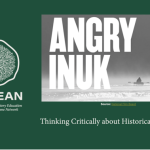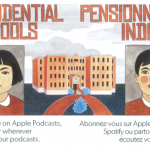Dr. Rose Fine-Meyer
OISE, University of Toronto
Welcome back to another school year! I hope it is a positive year for everyone. I am thrilled to be writing a column this year about where to access women’s historical narratives for your history courses, and how you might incorporate them in new ways. Women are half the population, but do not receive half the focus in history courses. The work to include women in history courses relies heavily on teacher commitment but there are plentiful resources available and I hope this column will provide some good resources and a few ideas of how they might work.
So in honour of Labour Day and a return to our classrooms, this column will focus on women and labour. Women have always worked both inside and outside the home. In pre-colonial societies, Indigenous men and women shared invaluable roles within their societies. European culture established that men were superior to women and settler socialites embraced similar gender divisions. Patriarchy lessened the traditional, honoured, and respected roles Indigenous women had as leaders in their communities.
Women have always responded and actively participated in the demands of social and economic survival. Since the 1960s, feminist historians have been researching and writing about women’s historical experiences. Canadian historians such as Joan Sangster, Joy Parr, Veronica Strong-Boag, Sarah Carter, Bettina Bradbury, Linda Kealey, Franca Iacovetta, Michelle Dumont, Afua Cooper, Sheila Cote-Meek and others have shared women’s diverse experiences. All women with families worked tirelessly to address their multiple economic needs. With the introduction of factories in the late 19th century, that replaced the home cottage industries, women were employed outside the home in multiple jobs, as dressmakers, seamstresses, launderers, milliners and saleswomen. They continued to work on farms, and as housekeepers, teachers and nurses. All labour, found women working in some direct or indirect capacity. And all women, past and present, faced challenges in terms of labour recognition, issues of exploitation, and lack of equal pay. This has meant the invisibility of women’s labour. Often “outside” the national narrative of most nation-state stories, women’s labour stories provide an important lens into our collective histories.
Keeping in mind that gender has never been a single category, it is important to incorporate women’s labour stories in classrooms within broader frameworks. Gender, race, and class are intertwined and this is evidence in the history of labour. The Abolition of Slavery across the British Empire, for example, did not erase colonial racial hierarchies. Racially marked women were denied access to specific work positons, often without adequate economic compensation.
All history courses include the topic of labour and so it challenges history teachers to find space to explore women’s labour, no matter place or date, and to seek out those stories that place them equally into the historical narratives of which they have been removed. Women have always worked, in maintaining their homes and communities, in the production or defence of war, in the raising of children and citizens, in the labour of industry, in organizing and advocating for social, legal, and economic change and in their activism to make change happen.
There are too many women to note individually as women’s labour is present and active throughout all of history. So please check out some of these websites and good luck including their labour stories!
To start off your school year, I have compiled a list of excellent websites that contain educational resources about women’s historical experiences.
General books first!
- Canadian women: A History. An excellent general history book
- Gail Cuthbert Brandt, Naomi Black, Paula Bourne, and Magda Fahrni. Canadian Women: A History, 3rd edition (Toronto: Nelson Education, 2011)
- Indigenous Women and Work: This anthology contains an excellent collection of essays.
- Carol Williams, ed. Indigenous women and work: from labor to activism. (Urbana: University of Illinois Press, 2012)
- The Graphic History Collective: “Founded in 2008, the Graphic History Collective (GHC) is a group of activists, artists, writers, and researchers passionate about comics, history and social change.” Lots of stories about and by women http://graphichistorycollective.com/
Websites to check:
- Indigenous women: First explore local community websites, and First Nations, Inuit, and Metis publishers, such as:
Muskrat Magazine
New Journeys. Strong women and survivors stories
And then check out complied websites:
Lakehead, Indigenous Traditional stories
OISE, University of Toronto, Deepening Knowledge resources for teachers:
- https://www.oise.utoronto.ca/deepeningknowledge/Teacher_Resources/index.html
- https://guides.library.utoronto.ca/Aboriginalpublishers
Infusing Indigenous Perspectives in K-12 Teaching
Government sites:
- https://www.rcaanc-cirnac.gc.ca/eng/1466616436543/1534874922512
- http://fnn.criaw-icref.ca/images/userfiles/files/LWM4_ColonialismWomen.pdf
- The Ontario Women’s History Network:
After checking the resources, you might benefit from attending the next Ontario Women’s History Conference which will be held in London on October 25-26, 2019 at Museum London. It’s a wonderful chance to network and learn about women’s history as well as access great resources for your classroom:
- The Canadian Committee on Women’s History – Comité canadien de l’histoire des femmes (CCWH-CCHF):
One of the largest committees affiliated with the Canadian Historical Association. Founded in 1975, their goal is to promote teaching and research in the field of women’s history. Check out their many resources:
- The Multicultural History Society of Ontario: http://mhso.ca/wp/
The MHSO has digitized primary source materials and made them available online. Strangers No More: Immigrant History and Multicultural Canada, provides access to its collections. Indigenous histories became an additional content focus when the Society added a collection of Indigenous oral history interviews. Ojibway and Cree Cultural Centre (OCCC) conducted over 300 interviews, the vast majority in Cree, Oji-Cree and Ojibwe, with Elders in First Nation communities in northern Ontario.
- The Ontario Black History Society:
- http://www.blackhistorysociety.ca/
- http://www.blackhistorysociety.ca/historical-profiles.html
The society is dedicated to the study, preservation and promotion of Black History and heritage” They have an excellent education link with historical profiles.
Journal articles: CHA, for example and regional journals, such as Acadiensis. Here is an article by Claudine Bonner who explores the role of women in the civil rights movement in Nova Scotia.
- Rise Up! A Digital Archive of Feminist History
Rise Up is a “digital archive of feminist activism in Canada from the 1970s to the 1990s. We were part of a worldwide wave of liberation and anti-oppression movements that won some victories, changed some attitudes, and radically altered the gendered and political landscape.”
- Canada’s History Society: Canada’ Great Women:
- https://www.canadashistory.ca/explore/women/canada-s-great-women
- https://mailchi.mp/canadashistory/bring-womens-history-into-your-classroom-with-these-resources
Canada’s History webinar series
- Archives of Ontario: http://www.archives.gov.on.ca/en/about/research_home.aspx
The Archives of Ontario has extensive primary sources holdings. The education department is most supportive. Their resources cover a variety of topics and subject areas and are available for download. Checkout out the diaries and watercolours by Elizabeth Simcoe.
- Historica. They have a Women in History Educational portal:
- http://education.historicacanada.ca/en/collections/32
- https://www.rcaanc-cirnac.gc.ca/eng/1466616436543/1534874922512
- The Great Unsolved Mysteries in Canadian History.
These “cold cases” from the past are solved by your students. Several feature women, for example: “Torture and Truth: Angélique and the Burning of Montreal. Check out the Teachers Guides!
- Merna Forester: 100 Canadian Heroines: Famous and Forgotten Faces http://www.heroines.ca/about/100canadianheroines.html


